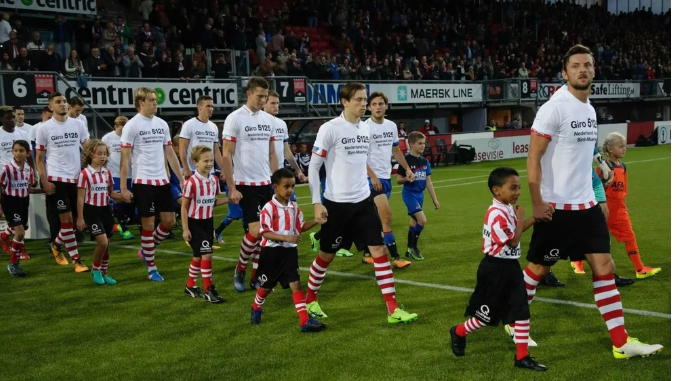
Bart Vriends (right) leads Sparta Rotterdam onto the pitch before a match. Photo supplied by Adelaide United
Adelaide United announced on Sunday that Eredivisie stalwart Bart Vriends has signed a two-year contract with the Reds.
Vriends, who captained Sparta Rotterdam and made over 200 appearances in the Dutch top flight, is known to be a strong defender who dominates aerial duels and is an attacking threat from set pieces.
But exactly what sort of player can United fans expect to see take the field at Hindmarsh next season?
Defending
A centre-backs primary purpose is simple: defend.
Vriends is perfectly adequate in that department, and cemented his spot in Sparta’s side, and his role as captain, through hard work and clinical defending.
The following graph shows how Vriends’ performance over the last calendar year compares to other centre-backs in Europe’s ‘next 14’ leagues (the best leagues outside of the top five):
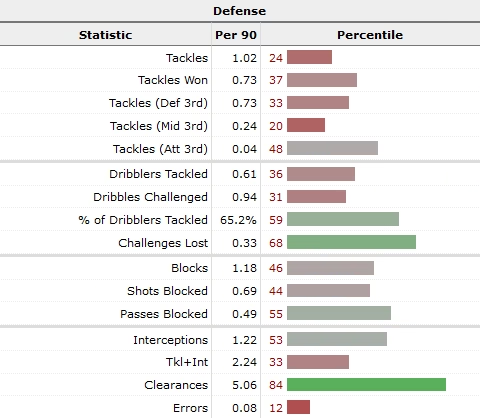
There are a couple of stats that stand out here.
We can see that Vriends is very effective at clearing the ball, rarely loses challenges and is above average at intercepting and blocking passes.
However, you can not fail to notice his rather lacklustre tackling stats, where he sits firmly below the 50th percentile in all of them.
There are two reasons why this is not necessarily the big issue it might seem.
Firstly, he has a win rate of 72 per cent for all tackles – so while he does not accumulate a lot, leaving him in a low percentile, he does win them when he makes them. This suggests that he often found himself not needing to make tackles (likely off the back of winning the ball elsewhere such as via interceptions).
That also leads to the second point, which is that Vriends was not used in a role that encouraged him to step up and engage the ball carrier. Rather, as his clearances stat suggests, he was used as a sweeper to clean up the play behind the line.
As this example from Sparta’s final home game of the 23/24 season against Heerenveen shows, rather than stepping up to engage the ball carrier, Vriends drops and tracks the runner:
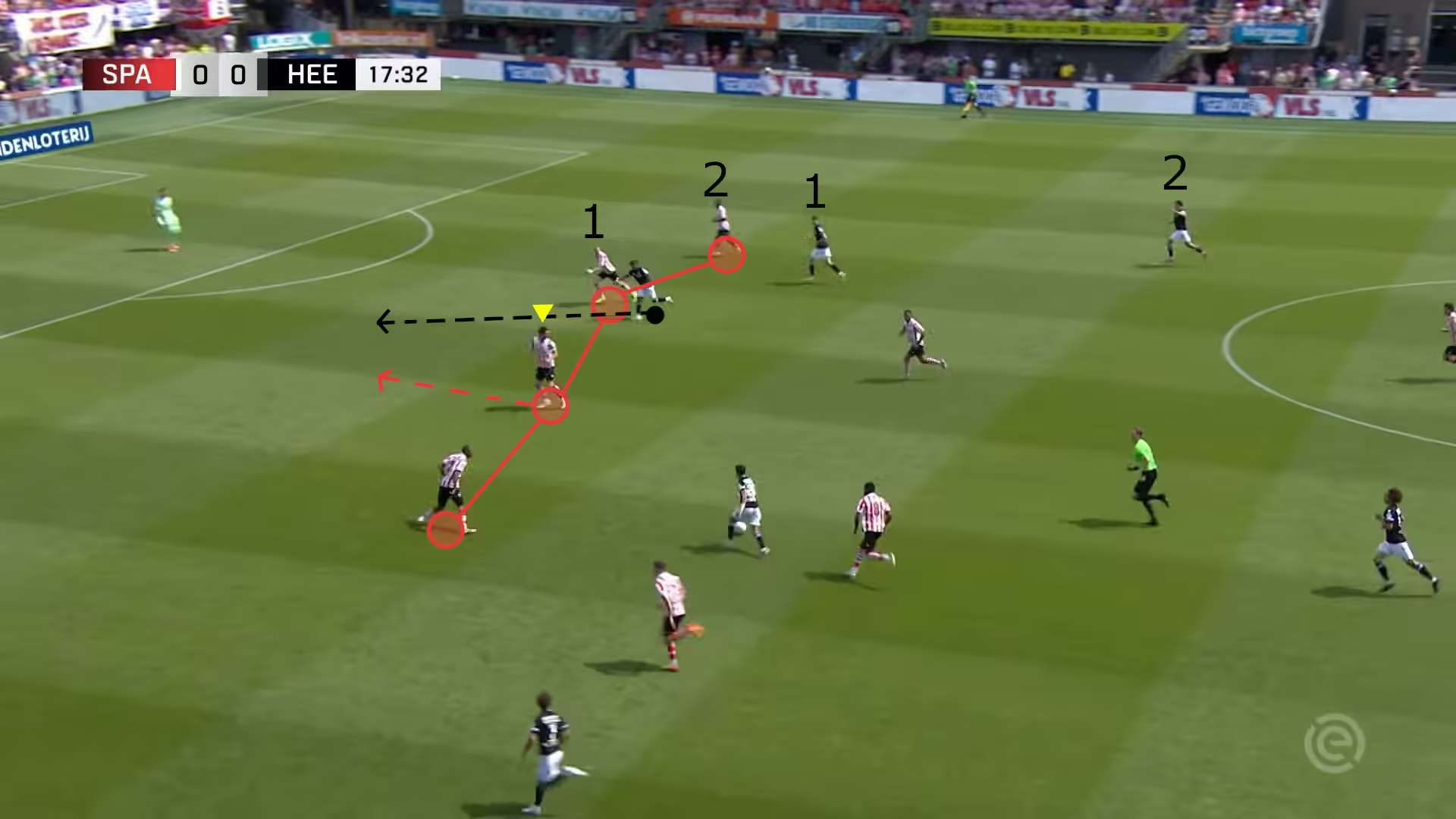
Now, this could be a system thing – where he is told to sit deeper and keep the ball in front at all times, but it could also be a display of his footballing IQ.
By challenging the dribbler, Vriends leaves the defence open to being outnumbered. With the Heerenveen fullback making a late run out wide, it would leave the left side of the defence in a 2 vs 3.
So, Vriends drops to pick up the central runner, allowing the other defenders to take one-on-one man marking assignments and not open up any runs from deep.
Indecision in this phase of play was a big killer for Adelaide’s defence last season, so someone with the awareness and capability of Vriends will allow the other defenders to commit to challenges knowing they have solid cover.
In Possession
Vriends’ Wikipedia page suggests that he is not as good on the ball as he is at defending, which is a bit harsh.
Is he going to set the league alight with his intricate passing moves? No, but he is assured and confident on the ball, and the underlying stats suggest he is probably better than he gets credit for.
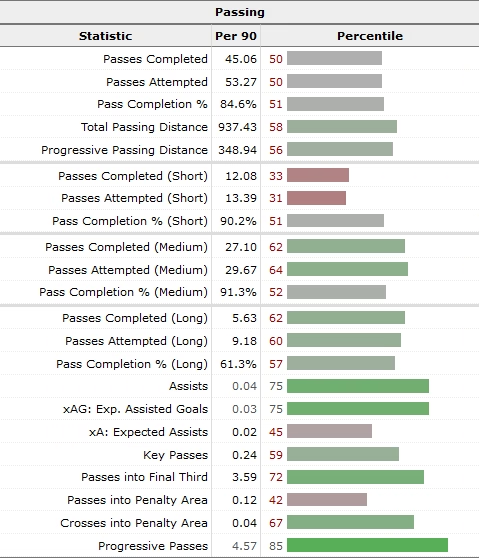
As this data shows, Vriends is at or above average in nearly every passing metric. He is not a conduit during build up, but is more than capable of playing effective balls forward.
The standout figure is his progressive passing, where he ranks in the 85th percentile. FBRef defines a progressive pass as one that moves the ball 10 yards closer to the goal than it had been in the last six passes.
Essentially, Vriends has a tendency to play the ball forward when used in build up. He does not recycle possession, and instead looks to work the ball into the midfield or out to a winger to keep the ball moving.
His long passing accuracy, while only slightly above average, is significantly better than what Adelaide’s centre-backs offered last season: Ben Warland had just a 33 per cent long pass accuracy, and Ansell wasn’t much better at 39 per cent.
This could open up a more direct attacking route for United next season, and with the recently added pace of Dylan Pierias it could become a cornerstone of the side’s attacking philosophy.
Aerial Ability
Arguably, Vriends’ biggest upside is his incredibly ability in the air.
Standing at just over 6 foot, he is not the tallest player in the world, nor is he the shortest. But his tremendous movement off the ball, fantastic leap and solid awareness contribute massively to his dominance in the air.
Vriends is in the 92nd percentile in aerial duels won per 90, as well as the 82nd percentile in terms of aerial duel win rate. This is obviously a huge boost defensively, but also makes him a threat in the attacking area.
The underlying stats show that Vriends is one of the best centre-backs in finding himself in goal scoring opportunities. This is due to his tremendous IQ and movement, as we can see in one of Sparta’s matches against Garang Kuol’s Volendam last season:
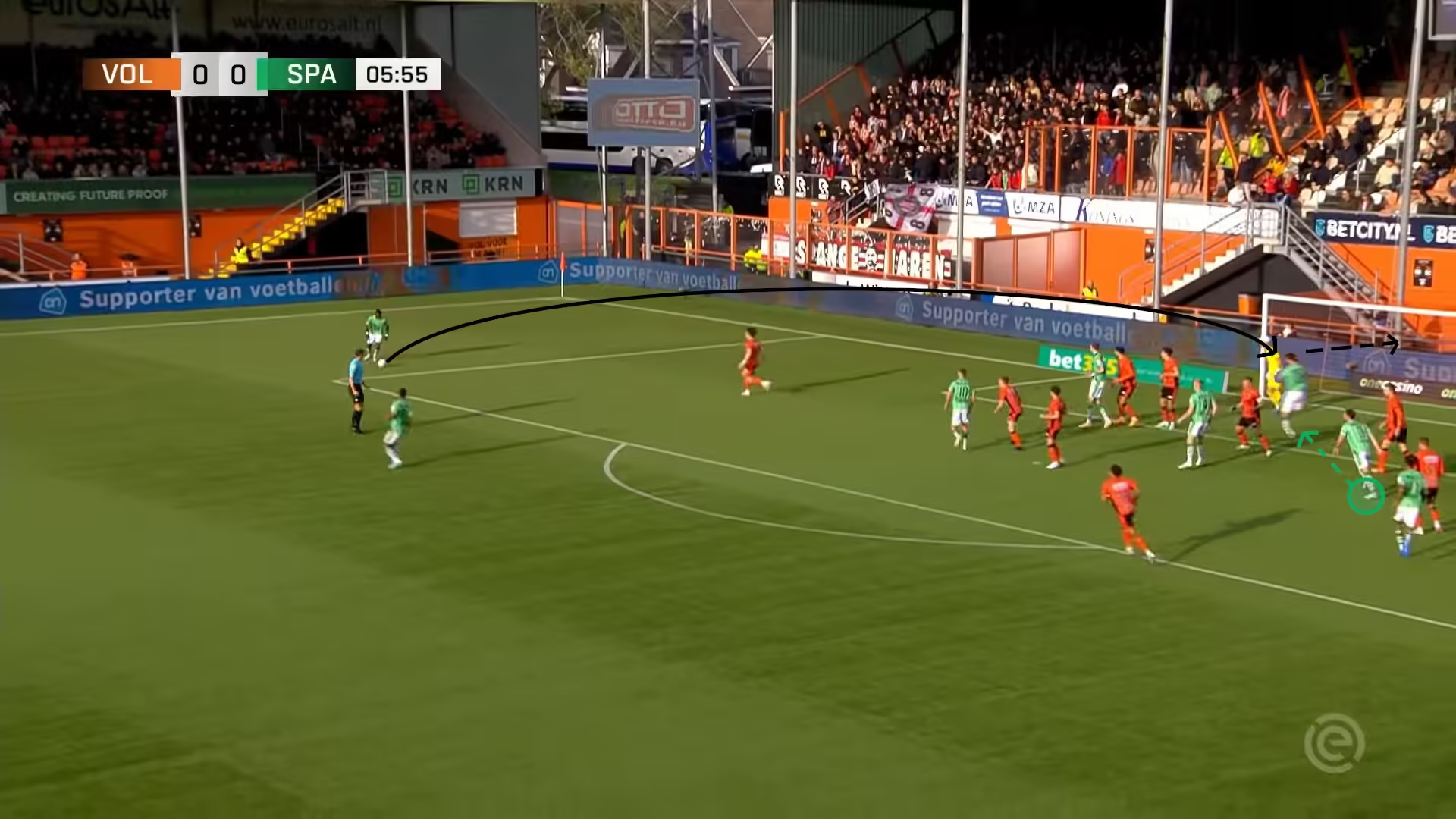
Here, Vriends not only identifies that the Volendam defence is playing a soft zone marking system (one where it isn’t a focus to go man-on-man) and can see the space between the two defenders.
It is a relatively simple move, but it is well executed by Vriends who finds himself perfectly on the end of the cross with a simple headed finish.
This movement, combined with the fact that he can leap above defenders with ease makes him a very big threat in the air, and a potential target from attacking set pieces.
Fitness and Injuries
For a few Adelaide fans, the fact that Vriends is the wrong side of 30 years old may ring alarm bells.
Injuries to large portions of the squad and ageing players have at times hampered the Reds over the last few seasons.
The sweet relief, though, is that for the most part, Vriends is relatively bullet proof.
He missed a few games to muscle injuries in the 2023/24 Eredivisie season, but was always able to play himself back into form relatively quickly.
Another aspect of his game that will prove exciting to Reds fans is that Vriends, despite being a tall, strong, veteran centre-back, is not a complete liability tracking back.
He is not the quickest player you will ever see, but he is more than capable of picking up the pace, and while typically used in a deeper defensive role, he can hold his own if caught out on the break.
How Will Adelaide Use Him?
That is going to be a case of wait and see.
At Sparta, he was the deeper of the two centre-backs, used sporadically in build up and was mostly the rock around which Sparta would structure themselves out of possession.
He also benefitted from a tremendously talented keeper, whose long range passing opened up the game and limited Vriends’ touches in dangerous areas.
The pair operated well together to ensure that opposition attackers could not generate high xG chances from their shots, using Vriends’ defensive capabilities to complement the keeper’s shot stopping.
With his leadership experience, it is quite likely we will see Vriends used alongside a younger defensive partner, perhaps Panagiotis Kikianis.
Regardless of who his central defensive partner ends up being, there is no doubting that Vriends will become the defensive anchor as he was at Sparta.
Adelaide has been crying out for a capable central defender to build a unit around, and they have now got one in Vriends.
Conclusion
Reds fans have plenty of reasons to be optimistic about this signing.
Vriends is not only a player of need, but he is also highly experienced, a true leader, mentor, and a tremendous footballer.
Adelaide United finally has their man at the heart of defence; and one who can finish attacking moves as well as he can stop them.
There are plenty of holes still to fill, but this is a real statement signing, and is perhaps an indication that the Reds’ management are looking to heavily invest in quality players to improve performances on the pitch.
